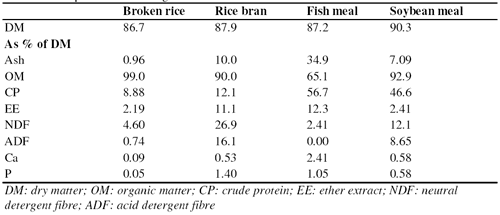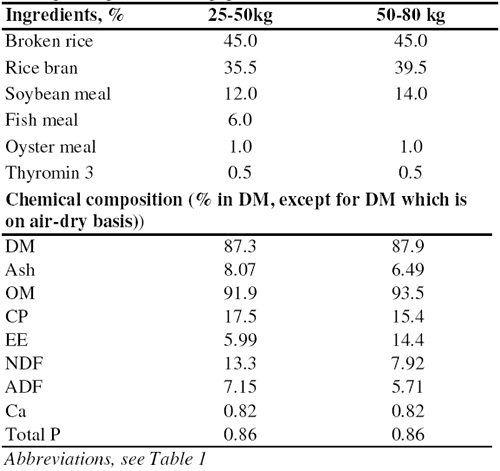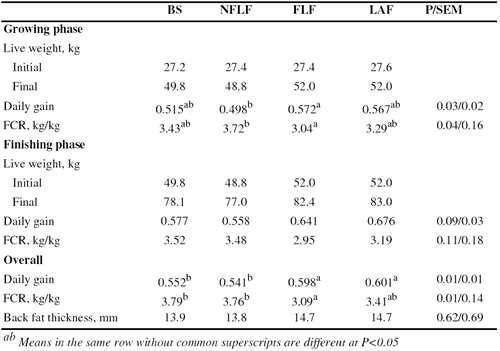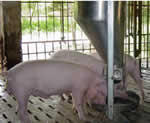- Animal health
- Animal Nutrition
- Genetic and Biodiversity
- Environment and natural resources protection
- Socio-economy in pig production sector
- Quality and food safety
- Animal husbandry and sustainable practices
- Rural Development
Fermented liquid feeds | Effects of fermented liquid feeds on the performance, digestibility, nitrogen retention & plasma urea nitrogen of growing-finishing pigs
In Vietnam, liquid feeding is a traditional practice. However, fermented liquid feed is also used for lactating sows, but is not commonly used for growing and finishing pigs where the available data of the effects of fermented liquid feed are limited (with the permission of Livestock Research for Rural Development).
Introduction
Concepts of non-fermented liquid feed (NFLF) and fermented liquid feed (FLF) have been defined by Canibe and Jensen (2003). The former is as a mixture of feed and water made immediately before feeding. The latter is a mixture of feed, such as a source of starchy feed like broken rice, or a complete feed and water stored in a tank at a certain temperature and for a certain period of time before feeding to the animals. A characteristic of FLF is a high concentration of lactic acid bacteria, yeasts, and lactic acid, low pH, and low enterobacteria counts. The benefits of liquid feed have been shown by many researchers (Cumby 1986; Scholten 2001; Canibe and Jensen 2003), and include an increase in daily feed intake and live weight gain compared with dry feeding (Brooks et al 1996; Jensen and Mikkeisen 1998). Geary et al (1999) and Lawlor et al (2002) reported that pigs offered fermented liquid feed performed similarly to pigs given feed acidified with lactic acid. In Vietnam, liquid feeding is a traditional practice in small holder farmer pig production. However, fermented liquid feed is also sometimes used for sows after farrowing, but is not commonly used for growing and finishing pigs. The available data of the effects of fermented liquid feed for growing pig are also limited.
The aim of the study was to examine the effects of non-fermented liquid feed and fermented liquid feed, prepared by traditional methods, on performance, intake, digestibility and plasma urea nitrogen (PUN) of growing and finishing pigs and to compare these with acidified and dry feeds.
Materials and Methods
Animals
20 weaned pigs at a live weight of approximately 25 kg were individually penned and given the experimental diets for a period of 90 days.
Treatments and design
The ratio of water and basal diet was 2:1 for treatments FLF and LAF. All diets were formulated to contain 17 and 15% CP in DM for the growing and finishing periods, respectively (Tables 1 and 2).
The experimental diets were allocated according to a complete block design with 5 replicates and 1 pig per replicate.
Preparing inocula
Inocula were prepared by soaking broken rice in water at a ratio of 1:3 in a plastic container for 3 days. The broken rice was considered to have been fermented when the pH of the batch reached 4 or less, and was then used as inocula.
Preparing fermented liquid feed (FLF)
The broken rice in the diet was mixed with inocula at a ratio of 1:3 and soaked in water at a ratio of 3:1 in a container overnight. The fermented mixture (FBR) was checked before being used as feed. Two parts of FBR were removed daily and fed, and then a new batch of broken rice was added to the reminder so that the container always contained a sufficient amount for the next day's feed. The feed was mixed each day, and consisted of FBR with rice bran, soybean meal, fish meal and premix of vitamins and minerals.
Acidified liquid feed
Acidified liquid feed was prepared daily by adding food grade lactic acid (made by fermentation; Lactic acid FCC special 88, Spain) at a predetermined rate to reduce feed pH to 4.0 (42 g lactic acid/ kg dry feed).
Table 1. Composition of diet ingredients

Table 2. Ingredients and chemical composition of experimental diets (growing and finishing phases)

Digestibility trial
The digestibility trial was carried out when the pigs reached approximately 50 kg (at the end of the growing period). The collection period was 5 days, and faeces were quantitatively collected daily and stored at -18oC. At the end of the experiment, sub-samples were taken, mixed and dried at 60oC prior to analysis. Blood samples were taken at the end of the collection period to determine plasma urea nitrogen (PUN).
Laboratory analysis
Prior to analysis, feed samples were ground through a 1-mm screen using a laboratory hammer mill. Analyses of feed samples were performed following the Association of Official Analytical Chemists (AOAC,1984) in duplicate. Acid detergent fibre (ADF) was determined according to Van Soest et al (1981) and AOAC (1984). Neutral detergent fibre (NDF) was analysed according to Van Soest et al (1991) as modified by Chai and Udén (1998). Feed pH was taken and measured each morning after mixing with the other diet ingredients. Fermented broken rice remaining in the container after replenishment and mixing with new broken rice was measured for pH. The pH meter used (digital pH meter 831, Japan) was calibrated daily using buffers of pH 4.01 and 6.86. Blood samples were taken via external jugular at the end of each period of the trial and placed in ice before centrifugation. Plasma was collected from blood and analysed for plasma urea nitrogen (PUN) using the Urease Indophenol method (Wako Pure Chemical Industries, Ltd., Japan) by colorimetric procedure.
At the end of the trial, back fat thickness was measured with an ultrasound device (Renco Lean-meater), detected between the 10th and 12th rib. The formula used for the adjustment was:
FAT READING x FACTOR
The pigs were fed two times daily (at 09:00 h and 15:00 h) and offered the diets close to ad libitum feeding. Data on feed intake was collected daily and live weights of individual pigs were recorded monthly. Daily dry matter intake (DMI) and average daily gain (ADG) were recorded for individual pigs and feed conversion ratio was calculated as DMI divided by ADG.
Statistical analysis
The effects of dietary treatment on daily gain, feed conversion ratio and digestibility were analyzed using the GLM model (Minitab version 13.2, Ryan, 2000):
The model was: Yij = µ + ai +gj + eij
Where Yij is the dependent variable, µ is the overall mean; ai is the effect of diet, i = 1, 2, 3, 4; gj is the effect of block, j = 1, 2...5; eij represents random error. When there was an overall effect of diet, differences between means were compared by Tukey's least significant difference method, declared at P < 0.05.
Results and discussion
Feed intake
The effects of dietary treatment on feed intake are presented in Table 3. Overall, dry matter intakes were similar among treatments.
Table 3. Effect of dietary treatment on feed intake (kg/day) of grower-finisher pigs

Pig performance
The effect of dietary treatment on pig performance is presented in Table 4. During the growing phase, pigs offered the FLF and LAF diets had a higher daily gain (0.572 and 0.567 kg/day, respectively) (P < 0.05) than those on the BS (0.515 kg/day) and NFLF diets (0.498 kg/day). For the finishing phase, the daily gains tended to be higher in diets FLF (0.641 kg/day) and LAF (0.676 kg/day) as compared to the BS (0.577 kg/day) and NFLF (0.558 kg/day) diets, but the difference was not significant (P>0.05). However, for the overall feeding period, the daily gains of pigs offered diets FLF (0.598 kg/day) and LAF (0.601 kg/day) were similar, and significantly (P<0.01) higher than for the BS (0.552 kg/day) and NFLF (0.541 kg/day) diets.
Feed conversion ratios (FCR) during the growing phase were significantly lower (P<0.05) for pigs fed diets FLF and LAF (3.04 and 3.29 kg/kg gain, respectively) than for pigs offered diets BS (3.43 kg/kg gain) and NFLF (3.72 kg/kg gain). During the finishing phase FCR was similar among diets, although slightly lower in FLF and LAF. Overall, FCR of diets FLF and LAF were lower than for BS and NFLF (P<0.01).
Back fat thickness was similar among diets (P>0.05).
Table 4. Effect of dietary treatment on performance of grower-finisher pigs

The results for nutrient digestibility and PUN are presented in Table 5. Dry matter digestibility was similar among diets, but OM digestibility was significantly (P<0.05) higher in the FLF diet (86.6%). The OM digestibility of diets LAF (84.3%) and NFLF (84.4%) were similar and the lowest value was found in the BS diet (81.6%). Similarly, crude protein digestibility was significantly different amongst treatments and was highest (P<0.05) in FLF (85.9%) and lowest in BS (79.6%), while digestibility of NFLF and LAF was similar (80.7 and 81.2%, respectively). As consequence, the PUN values were significantly different (P<0.05) among diets: PUN values of FLF (15.1 mg/dl) were lower than those of the BS (19.3 mg/dl), NFLF (22.9 mg/dl) and LAF (21.8 mg/dl) diets.
Table 5. Mean values for nutrient digestibility and plasma urea nitrogen (PUN)

The economic analysis is shown in Table 7. The fermented liquid and lactic acid feeds resulted in increased live weight gain and lower feed conversion ratio. However, the price of lactic acid is very high (40,000VND/kg), and to achieve a diet pH of 4, the quantity of lactic acid needed was 4.2% of the diet, which increased the cost of diet LAF by 47.4% as compared to the BS diet. Feed cost/gain of FLF was lowest.
Table 6. Economic analysis

Discussion
A simple method to ferment feed was successfully carried out in this study. Broken rice is a starchy feed source, and therefore viable inocula could be continuously maintained during the experimental period, and no deterioration was found. The study was conducted during the rainy season and in the transition period from wet to dry, and especially during finishing period, the ambient temperature varied considerably, from cool and windy to hot (20 to 35oC). Therefore, the performance and intake of pigs were affected, as also shown by Nguyen van Soc (1996). However, the performance of the pigs given the fermented and lactic acid feeds was still improved as compared to those given the dry and non-fermented liquid feeds.
The results for growth rates in the present study are in agreement with those of Geary et al (1999), who reported that pigs offered liquid feed that was acidified with lactic acid performed similarly to pigs offered fermented liquid feed. The advantages of fermented liquid feed have been shown by many authors (Cumby,1986; Scholten 2001; Lawlor et al 2002). Fermented liquid feed causes a decrease in gastric pH and increases numerically the gastric concentration of lactic acid as compared to dry feed and non-fermented feed (Canibe and Jensen 2003), by reducing enterobacteria, and thus enhances gut function.
However, Canibe and Jensen (2003) found that the daily gain of pigs offered NFLF was higher than that of FLF, which was a complete feed fermented with water for some days. The difference was probably a result of different types of fermented feed used (Jensen and Mikkelsen 1998). At high temperatures in tropical countries, deterioration can occur, and there can be an increased risk of Salmonella infection when soaking a complete feed in water for a certain period (van der Wolf et al. 1999). Therefore the fermentation of starchy feed is recommended.
The performance of pigs offered NFLF was not improved by addition of water as compared to dry feed, and this result is in agreement with those of Brooked et al (1996) and Lawlor (2002), who reported that gain/feed of piglets offered liquid feed was similar to that of dry feed. This is in contrast to the findings of Partridge et al (1992), who reported that liquid feeding increased daily gain during a three weeks trial period. The study showed that the pigs faced with drinking so much water consumed less energy, as also shown by Smith (1976). Moreover, some diet ingredients have different specific gravity, such as non-fermented broken rice, which was left in the bottom of the trough. Pigs refused to eat these sediments, and thus there was a considerable feed wastage. Recognizing the importance of the water:feed ratio, this was reduced to 2:1 instead of the ratio of 3:1 that was previously intended.
Protein solubility is very dependent upon pH, and at pH 4, fermented feed protein is easily broken down and becomes more soluble, as confirmed by Longland (1991), who found that a low pH promoted protein digestion in the stomach. As protein moves towards the small intestine more protein is degraded and absorbed. As a consequence, the lower PUN of pigs offered FLF, as compared to the other dietary treatments, indicates a reduced urea synthesis and more efficient use of amino acids for body tissue growth. Nutrient digestibility data from growing pigs offered the fermented feed in the present study tend to support this.
Conclusions
References
- AOAC 1984 Official methods of Analysis. Association of Official Analytical Chemists. Washington, DC.
- Brooks P H, Geary T M, Morgan D T and .Campbell A 1996 New developments in liquid feeding. Pig J. 36:43-64.
- Canibe N and Jensen B B 2003 Fermented and nonfermented liquid feed to growing pigs: Effect on aspects of gastrointestinal ecology and growth performance. Animal Society of Animal Science. Anim. Sci. 81:2019-2031.
- Chai. W and Udén P 1998 An alternative oven method combined with different detergent strengths in the analysis of neutral detergent fibre. Anim. Feed Sci. Technol. 74, 281-288.
- Cumby T R 1986 Design requirements of liquid feeding systems for pigs: A review. J Agric. Eng. Res. 34:153-172.
- Geary T M, Brooks P H, Beal J D and Campbell A 1999 Effect on weaner pig performance and diet microbiology of feeding a liquid diet acidified to pH 4 with either lactic acid or through fermentation with Pediococcus acidilactici. J. Sci. Food Agric.79:633-640.
- Jensen B B and Mikkelsen L L 1998 Feeding liquid diets to pigs. In: P C Garnsworthy and J Wiseman (ed.) Recent Advances in Animal Nutrition. p 107. Nottingham University Press, Nottingham, UK.
- Kornegay E T, Thomas H R, Kornegay E T, Thomas H R, Handlin D L, Noland P R and Burbank D K 1981 Wet versus dry diets for weaned pigs. J. Anim. Sci. 52:14-17.
- Lawlor P G, Lynch P B, Gardiner G E, Caffrey P J and O'Doherty J V 2002 Anim. Sci. 80:1725-1735.
- Longland A C 1991 Digestive enzyme activities in pigs and poultry. In: M F Fuller (ed.) In Vitro Digestion for Pigs and Poultry. p 3. CAB International, Wallingford, Oxon, UK.
- Nguyen van Sóc 1996 Nang su?t sinh s?n c?a heo nuôi t?i tr?i Phu?c Th? Vinh Long. Mimeograph. Vietnamese.
- Partridge G G, Fisher J, Gregory H and Prior S G 1992 Automated wet feeding of weaner pigs versus conventional dry diet feeding: effects on growth rate and food consumption. Anim. Prod. 54:484 (Abstr.).
- Ryan B, Joiner B L and Ryan Jr T A 2000 Minitab statistical software release 13. Duxbury Press.
- Scholten R, Rijnen M J A, Schrama J W, Boer H, Vesseur P C, den Hartog L A, van der Peet-Schwering C. M C and Verstegen W A 2001 Fermentation of liquid coproducts and liquid compound diets: Part 1. Effects on chemical composition during a 6-day storage period. J. Anim. Physiol. (Anim. Nutr.) 85:111-123.
- Smith P 1976 A comparison of dry, wet and soaked meal for fattening bacon pigs. Exp. Husb. 30:87-94.
- Van der Wolf P J, Bongers J H, Elbers A R W, Franssen F M M C, Hunneman W A, van Exsel M J M and Tielen M J M 1999 Salmonella infections in finishing pigs in The Netherlands: Bacteriological herd prevalence, serogroup and antibiotic resistance of isolates and risk factors for infection. Vet. Microbiol. 67:263-275.
Citation of this paper
Nguyen Nhut Xuan Dung, Luu Huu Manh and Ogle B 2005: Effects of fermented liquid feeds on the performance, digestibility, nitrogen retention and plasma urea nitrogen (PUN) of growing-finishing pigs. Livestock Research for Rural Development. Volume 17, Article #102. Retrieved September 7, 2005, from http://www.cipav.org.co/lrrd/lrrd17/9/xdun17102.htm
Comments
CIRAD © 2007 (All rights reserved) - Disclaimer stating - Page updated : 13/04/2007
